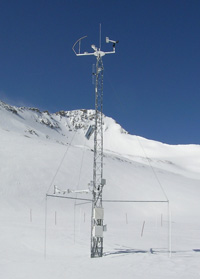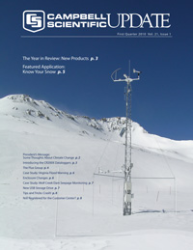With the arrival of winter in the Northern Hemisphere, many of us here in Logan, Utah, welcome the snow. Our vehicle license plates in Utah say "Greatest Snow on Earth," and the ski resorts are a popular destination for those looking to experience it.
 The snow, with all of its implications for play, travel, danger, and spring runoff, creates many needs for making measurements, and many snow-related applications benefit from our measurement and control systems. Our systems see use in and around ski areas, winter recreation areas, mountain towns, major highways, and other critical locations.
The snow, with all of its implications for play, travel, danger, and spring runoff, creates many needs for making measurements, and many snow-related applications benefit from our measurement and control systems. Our systems see use in and around ski areas, winter recreation areas, mountain towns, major highways, and other critical locations.
Ski areas, departments of transportation, and other organizations rely on automated weather stations to provide real-time weather data for use in evaluating avalanche danger. Many weather factors contribute to avalanche conditions, including significant precipitation, wind, and changing temperatures. The around-the-clock access to weather data from remote locations is a huge help to those involved in determining avalanche risk.
Ski resorts use measurement and control systems for other management and maintenance decisions, as well. Weather stations can control snow-making equipment based on measured conditions. Wind measurements can help determine when wind speeds are too high to safely operate lifts. New snow totals are always of interest to skiers. This information can be automatically posted to the Internet and displayed in graphical formats.
We've all seen how snow and ice affect our roads and we've seen the dangers they cause. By measuring precipitation, road-surface temperature, air temperature, and other parameters, road weather stations provide departments of transportation with critical information for keeping roads clear and safe. Weather station data can help road crews know where they need to plow, whether to lay salt or sand, and which roads may need to be closed.
Water managers also benefit from good measurements. Constant monitoring of the snowpack in mountain regions helps predict high and low water years and gives both government and private organizations time to act accordingly. The SNOTEL network of over 750 weather stations in the western United States gathers this type of data for water managers and decision makers. Data from the network have been used to accurately predict water supply well before spring runoff, resulting in better water management, informed farming and business decisions, and even advance flood preparation.
Typical Measurements
|
Low power consumption, multiple remote telemetry options, and reliable operation in harsh environments make our systems a natural fit for these and many other snow-related applications. It is always gratifying to know that our systems are contributing to operational and research goals of many different organizations by providing reliable, long-term monitoring.

